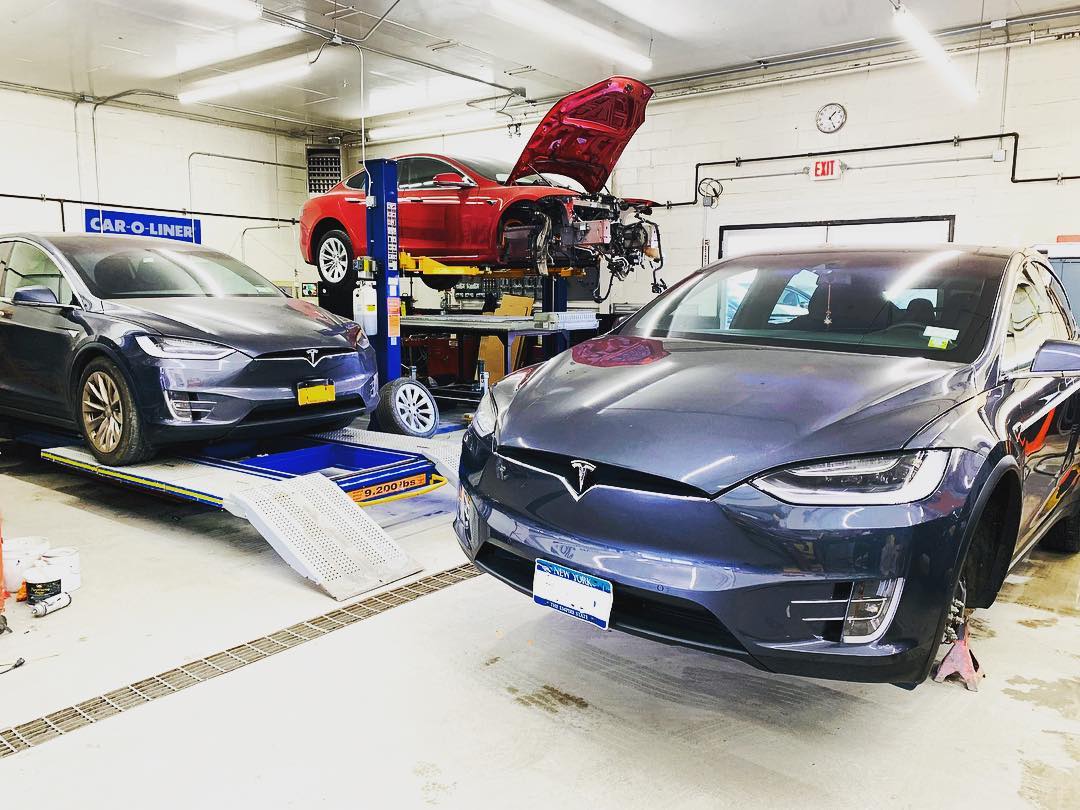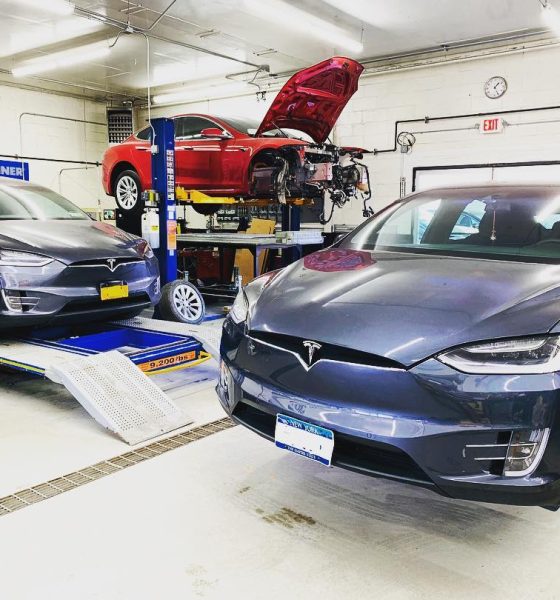

News
Tesla acknowledges its service challenges, pledges serious repair team ramp
It’s no secret that Tesla is experiencing challenges meeting the service needs of its customers, with some owners noting that appointments with the company’s service team are now available weeks or even months out. This has caused an issue of sorts for Tesla. Its vehicles may indeed provide the best ownership experience in the market — as long as they don’t require service. Once they do, then a substantial amount of patience is advised on the owners’ part.
The issue of Tesla’s service network and its present shortcomings was discussed by CFO Zachary Kirkhorn during the Q3 2021 earnings call. According to the executive, there are a couple of factors that contributed to the current service situation, from the pandemic and the world’s recovery from it, as well as the ongoing supply chain challenges. Kirkhorn noted, however, that some of Tesla’s service issues are not necessarily exclusive to the company.
“There’s a couple of things that have contributed to that based upon the information that we have. The first is that — and I think this is kind of not — this is not unique to us, is that the return to some sense of normalcy in a post-pandemic world has happened, I think, more quickly than most people expected. And what we’re seeing here is that the number of miles that people are driving has increased. There may have been some demand for service during 2020 or in the early parts of 2021 that customers put off, and so there’s a bit of a catch-up that’s occurring.
“That has increased demand for service. At the same time, in the macro-environment here, logistics, moving parts, sourcing parts has become increasingly more difficult, which is a well-known issue in the world right now, as well as challenges in the labor market. And so this kind of the simultaneous increase in demand for service with the ability to supply that service has been impacted for the reasons I mentioned. And so we saw an uptick primarily in Europe and North America in service wait times over the course of the summer,” Kirkhorn noted.
The Tesla CFO added that the company is doing what it can to grow its service network, from its physical centers to its mobile service fleet. Kirkhorn noted that over the last year, and despite the presence of the pandemic, Tesla’s physical service centers grew by 35%, and the mobile service fleet saw an even more impressive growth of 40%. But amidst these efforts, the CFO reiterated that Tesla’s primary goal is still to create vehicles that are extremely reliable, since the best service is no service.
“And we’ve been working extremely hard since then to address this, and we’ve seen our wait times come down. So this is not the case in every location, but if you think about it from regional average perspective, we are seeing improvements there. We remain super-focused on adding locations. And so over the last year, we’ve grown our physical footprint of service centers by 35%.
“We’ve grown our footprint of mobile repair by over 40%. We’re also adding staffing as quickly as we can in the areas that are most impacted by the imbalance of supply and demand for service. But I think the most important part about all of this is — and we’ve said this on calls before, where the best service is no service. And so we have been incredibly focused as a company both on the initial quality of our vehicles and reliability of our vehicles,” Kirkhorn said.
Don’t hesitate to contact us with news tips. Just send a message to tips@teslarati.com to give us a heads up.

News
Tesla FSD fleet is nearing 7 billion total miles, including 2.5 billion city miles
As can be seen on Tesla’s official FSD webpage, vehicles equipped with the system have now navigated over 6.99 billion miles.

Tesla’s Full Self-Driving (Supervised) fleet is closing in on almost 7 billion total miles driven, as per data posted by the company on its official FSD webpage.
These figures hint at the massive scale of data fueling Tesla’s rapid FSD improvements, which have been quite notable as of late.
FSD mileage milestones
As can be seen on Tesla’s official FSD webpage, vehicles equipped with the system have now navigated over 6.99 billion miles. Tesla owner and avid FSD tester Whole Mars Catalog also shared a screenshot indicating that from the nearly 7 billion miles traveled by the FSD fleet, more than 2.5 billion miles were driven inside cities.
City miles are particularly valuable for complex urban scenarios like unprotected turns, pedestrian interactions, and traffic lights. This is also the difference-maker for FSD, as only complex solutions, such as Waymo’s self-driving taxis, operate similarly on inner-city streets. And even then, incidents such as the San Francisco blackouts have proven challenging for sensor-rich vehicles like Waymos.
Tesla’s data edge
Tesla has a number of advantages in the autonomous vehicle sector, one of which is the size of its fleet and the number of vehicles training FSD on real-world roads. Tesla’s nearly 7 billion FSD miles then allow the company to roll out updates that make its vehicles behave like they are being driven by experienced drivers, even if they are operating on their own.
So notable are Tesla’s improvements to FSD that NVIDIA Director of Robotics Jim Fan, after experiencing FSD v14, noted that the system is the first AI that passes what he described as a “Physical Turing Test.”
“Despite knowing exactly how robot learning works, I still find it magical watching the steering wheel turn by itself. First it feels surreal, next it becomes routine. Then, like the smartphone, taking it away actively hurts. This is how humanity gets rewired and glued to god-like technologies,” Fan wrote in a post on X.
News
Tesla starts showing how FSD will change lives in Europe
Local officials tested the system on narrow country roads and were impressed by FSD’s smooth, human-like driving, with some calling the service a game-changer for everyday life in areas that are far from urban centers.

Tesla has launched Europe’s first public shuttle service using Full Self-Driving (Supervised) in the rural Eifelkreis Bitburg-Prüm region of Germany, demonstrating how the technology can restore independence and mobility for people who struggle with limited transport options.
Local officials tested the system on narrow country roads and were impressed by FSD’s smooth, human-like driving, with some calling the service a game-changer for everyday life in areas that are far from urban centers.
Officials see real impact on rural residents
Arzfeld Mayor Johannes Kuhl and District Administrator Andreas Kruppert personally tested the Tesla shuttle service. This allowed them to see just how well FSD navigated winding lanes and rural roads confidently. Kruppert said, “Autonomous driving sounds like science fiction to many, but we simply see here that it works totally well in rural regions too.” Kuhl, for his part, also noted that FSD “feels like a very experienced driver.”
The pilot complements the area’s “Citizen Bus” program, which provides on-demand rides for elderly residents who can no longer drive themselves. Tesla Europe shared a video of a demonstration of the service, highlighting how FSD gives people their freedom back, even in places where public transport is not as prevalent.
What the Ministry for Economic Affairs and Transport says
Rhineland-Palatinate’s Minister Daniela Schmitt supported the project, praising the collaboration that made this “first of its kind in Europe” possible. As per the ministry, the rural rollout for the service shows FSD’s potential beyond major cities, and it delivers tangible benefits like grocery runs, doctor visits, and social connections for isolated residents.
“Reliable and flexible mobility is especially vital in rural areas. With the launch of a shuttle service using self-driving vehicles (FSD supervised) by Tesla in the Eifelkreis Bitburg-Prüm, an innovative pilot project is now getting underway that complements local community bus services. It is the first project of its kind in Europe.
“The result is a real gain for rural mobility: greater accessibility, more flexibility and tangible benefits for everyday life. A strong signal for innovation, cooperation and future-oriented mobility beyond urban centers,” the ministry wrote in a LinkedIn post.
News
Tesla China quietly posts Robotaxi-related job listing
Tesla China is currently seeking a Low Voltage Electrical Engineer to work on circuit board design for the company’s autonomous vehicles.

Tesla has posted a new job listing in Shanghai explicitly tied to its Robotaxi program, fueling speculation that the company is preparing to launch its dedicated autonomous ride-hailing service in China.
As noted in the listing, Tesla China is currently seeking a Low Voltage Electrical Engineer to work on circuit board design for the company’s autonomous vehicles.
Robotaxi-specific role
The listing, which was shared on social media platform X by industry watcher @tslaming, suggested that Tesla China is looking to fill the role urgently. The job listing itself specifically mentions that the person hired for the role will be working on the Low Voltage Hardware team, which would design the circuit boards that would serve as the nervous system of the Robotaxi.
Key tasks for the role, as indicated in the job listing, include collaboration with PCB layout, firmware, mechanical, program management, and validation teams, among other responsibilities. The role is based in Shanghai.
China Robotaxi launch
China represents a massive potential market for robotaxis, with its dense urban centers and supportive policies in select cities. Tesla has limited permission to roll out FSD in the country, though despite this, its vehicles have been hailed as among the best in the market when it comes to autonomous features. So far, at least, it appears that China supports Tesla’s FSD and Robotaxi rollout.
This was hinted at in November, when Tesla brought the Cybercab to the 8th China International Import Expo (CIIE) in Shanghai, marking the first time that the autonomous two-seater was brought to the Asia-Pacific region. The vehicle, despite not having a release date in China, received a significant amount of interest among the event’s attendees.








